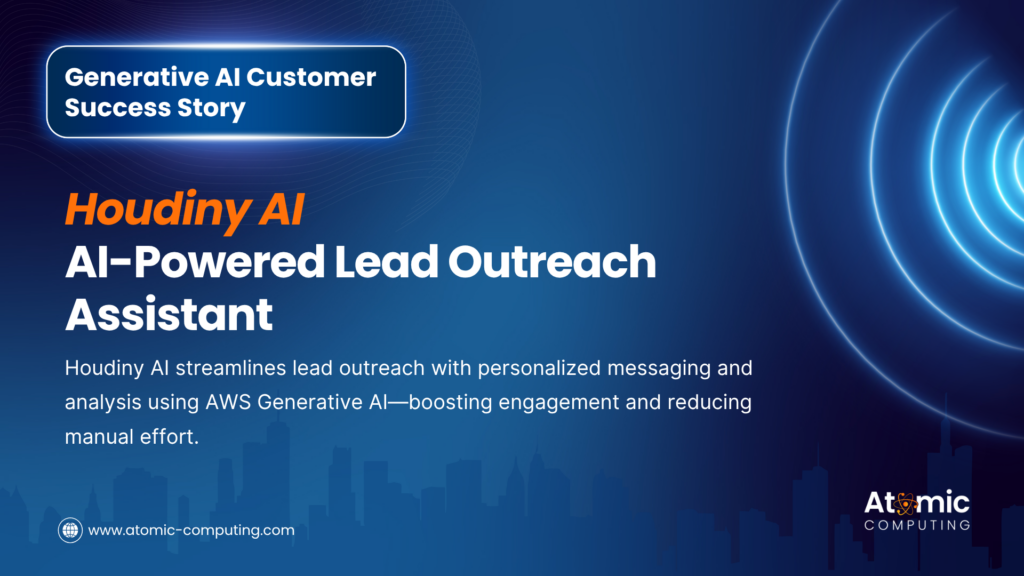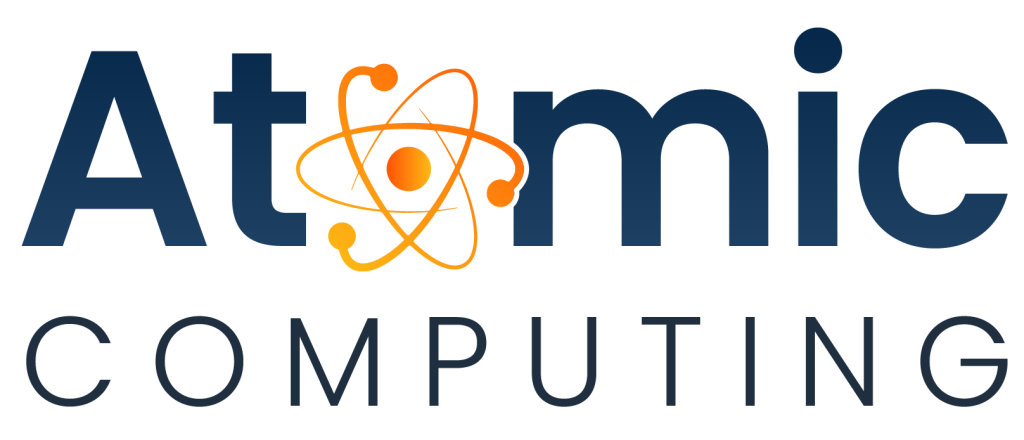Generative AI Customer Example: Houdiny AI- AI powered lead outreach assistant

1. Business Problem
In today’s fast-paced digital world, businesses and professionals need an efficient way to communicate with potential leads and clients. However, crafting personalized outreach emails, LinkedIn messages, and conducting thorough lead analysis can be time-consuming and inconsistent. Existing solutions often fall short in terms of automation, personalization, and accuracy, forcing businesses to manually manage multiple communication channels and analyze data across various platforms. This fragmentation of tasks creates inefficiencies, resulting in missed opportunities and reduced productivity.
The problem becomes even more evident when scaling these efforts for larger datasets. Businesses struggle to ensure that outreach is timely, relevant, and effectively tailored to each lead, while still maintaining high levels of engagement. A more unified, automated approach to lead outreach and analysis is crucial to streamline communication, improve outreach performance, and ultimately, drive business growth.
2. Project Objective
The primary objective of this project is to develop a comprehensive, AI-powered SaaS solution designed to automate and streamline the outreach process for businesses. The solution comprises three key components:
- Email Agent: This component generates personalized and targeted email outreach messages based on lead information. By automating the crafting of messages, businesses can ensure that every communication is relevant and timely.
- LinkedIn Agent: Similar to the email agent, the LinkedIn agent creates and sends messages tailored to potential leads on LinkedIn, allowing businesses to leverage this important networking platform for more effective engagement.
- Analysis Agent: This component performs in-depth analysis of lead data to help businesses identify key insights, including lead behavior, interests, and scores and categorize leads based on engagement patterns. It further supports the personalization of outreach strategies by providing actionable intelligence.
The solution combines the power of AI to automate these critical business functions, improving outreach efficiency, reducing manual effort, and ensuring that every lead interaction is optimized for maximum impact.
3. Business Problem and Traditional Approach
Traditional Approach Challenges:
- Manual Outreach: Businesses traditionally spent considerable time crafting personalized emails and messages for each lead, often leading to inefficiencies and missed opportunities. The process was labor-intensive, making it difficult to scale outreach efforts as the business grew.
- Slow Response Times: Without automation, businesses struggled to engage leads promptly, often resulting in delays that hindered timely communication and ultimately affected conversion rates. This slow turnaround time could frustrate leads, reducing their interest in further interaction.
- Fragmented Tools: Companies used a combination of tools for email campaigns, LinkedIn outreach, and data analysis, but these tools were often not integrated. This fragmentation caused inconsistencies in messaging and made it harder to track and manage outreach efforts across different platforms.
- Inefficient Data Analysis: Traditional methods of analyzing lead data involved manual reviews of spreadsheets or CRM systems, which was both time-consuming and prone to human error. This limited the ability to gain real-time insights and adjust outreach strategies quickly, reducing overall campaign effectiveness.
- Limited Personalization: While businesses made efforts to personalize outreach, the process was often inconsistent and lacked the scalability needed for larger datasets. As a result, many communications came across as generic, missing the opportunity to tailor content to individual lead preferences.
- Complex Data Management: Managing lead data manually across multiple platforms created unnecessary administrative overhead. This process was prone to errors and inconsistencies, reducing the time businesses could spend on strategy and decision-making.
4. Generative AI Solution on AWS
Solution Architecture
The AI-powered outreach solution utilizes AWS services to automate lead engagement, enhance message generation, and conduct real-time data analysis. The serverless design ensures scalability, reliability, and cost-efficiency, enabling businesses to automate outreach while keeping operational costs low.
Components of the Architecture:
- API Gateway: Acts as the entry point for connecting the frontend interface with the backend system. It receives requests from users, such as lead data or parameters, and routes them to the appropriate AWS services for processing.
- AWS Lambda (Function 1): This Lambda function processes incoming requests from the frontend through the API Gateway. It handles the user parameters, validates the data, and submits jobs for processing.
- Amazon S3 (Input CSV): The input CSV, containing lead data, is stored in an S3 bucket. It serves as the dataset for generating personalized outreach emails and LinkedIn messages.
- Amazon EventBridge: This service keeps track of the job status throughout the entire process. It allows for event-driven workflows and notifications, ensuring that the system provides real-time updates on the status of each job (e.g., processing, completed, failed).
- AWS Batch: Heavy computational tasks, including message generation and data analysis, are handled in AWS Batch. This ensures that the processing power can scale efficiently to handle large datasets.
- AWS Lambda (Function 2): Once processing is complete in AWS Batch, this Lambda function updates the job status and communicates the completion or error message to the user. It serves as the final point of interaction in the processing pipeline.
- Amazon S3 (Output CSV): The generated outreach messages are saved in a separate S3 bucket. This output CSV contains the final messages, ready for delivery.
- Amazon RDS: RDS is used to store and manage task IDs and job IDs, ensuring that each job is properly tracked and associated with the relevant user input and outputs.
- Amazon Bedrock (Claude-3.5-Haiku): The Claude-3.5-Haiku model, a generative AI model, generates contextually relevant and personalized content for emails and LinkedIn messages based on the lead data. This enhances the engagement and relevance of each communication.
AWS Generative AI-Specific Services Used:
- Amazon Bedrock: A foundational generative AI model accessed via its API through Amazon Bedrock. It generates intelligent, context-aware content by processing structured lead data and producing highly personalized outreach messages—such as emails and LinkedIn messages—based on predefined prompts for each module.
- AWS Lambda: Provides serverless orchestration of the entire workflow, including processing incoming data, handling requests, and managing the flow of information between different AWS services.
- AWS Batch: Handles large-scale processing of input CSV files, coordinating with Bedrock to generate personalized outputs. It enables efficient, parallel execution of compute-intensive tasks for all three modules—Email, LinkedIn, and Analysis—and stores results in output CSVs on Amazon S3.
5. Quantitative Business Impact Metrics
The introduction of the AI-powered lead analysis and outreach solution has resulted in substantial improvements in operational efficiency and business outcomes. Below is a breakdown of the measurable impact, with a focus on specialized and tested prompts, as well as the likelihood of engagement score and categorization:
| Metric | Before AI Implementation | After AI Implementation |
| Lead Response Time | ~5-10 minutes per lead (manual message drafting and outreach) | ~5 seconds per lead (AI-powered message generation) |
| Lead Engagement Rate | 50% engagement rate (manual outreach) | 75% engagement rate (automated personalized outreach) |
| Message Personalization | Generic messages sent to all leads | Highly personalized messages based on lead data and context |
| Likelihood of Engagement | No scoring or categorization | AI-driven engagement likelihood score and categorization for each lead |
| Bulk Message and Email Generation | Manual generation, time-consuming (2 hour for 100 leads) | Automated in seconds, capable of processing thousands of leads in minutes (3-4 minutes for 100 leads) |
| Customer Support Cost | High (manual agents required for follow-up) | Reduced by 50% (AI-driven followup response by automation) |
| Operational Efficiency | Manual data analysis and outreach process | Fully automated lead analysis and outreach generation |
| Lead Conversion Rate | 25% conversion rate | 40% conversion rate (due to higher message relevance and personalized followups) |
6. Business-Led Transformation Using Generative AI
The integration of Generative AI has transformed lead outreach and analysis by automating critical tasks, enhancing personalization, and streamlining operations. The key benefits include:
Automated Lead Engagement
AI automatically generates personalized emails and LinkedIn messages in seconds, reducing manual effort and significantly increasing lead engagement rates from 50% to 75%.
- Improves outreach efficiency by automating message creation, ensuring relevant, timely communication with minimal manual involvement.
Intelligent Lead Analysis and Prioritization
AI analyzes lead data and scores each lead’s likelihood of engagement, categorizing them as High, Medium, or Low.
- Maximizes conversion potential by focusing on high-priority leads, leading to better-targeted outreach and higher conversion rates.
Personalized Outreach
Using specialized prompts, the system generates tailored outreach for each lead based on specific data points and behaviors.
- Increases conversions from 25% to 40% by delivering messages that are highly relevant and personally tailored, improving the lead’s response rate.
Automated Bulk Message Generation
AI processes thousands of leads in minutes, eliminating the need for time-consuming manual message generation.
- Reduces time dramatically: 100 leads processed in 3-4 minutes instead of 2 hours, allowing businesses to scale outreach quickly and efficiently.
Cost Reduction and Efficiency
By automating follow-up responses and lead analysis, AI cuts customer support costs by 50% and significantly boosts overall operational efficiency.
- Freed-up resources allow businesses to focus on more strategic activities, improving productivity and reducing reliance on manual labor.
Real-Time Reporting and Monitoring
AI delivers real-time insights into lead interactions, engagement likelihood, and campaign success, enabling businesses to adjust strategies as needed.
- Ensures continuous optimization by providing actionable data to refine outreach strategies and improve results over time.
6. Deployment and Production Readiness on AWS
Deployment Environment: AWS Cloud
The solution is deployed on AWS Cloud, ensuring high availability, scalability, and reliability. The entire system leverages AWS services to manage lead analysis, message generation, and automation efficiently.
Production Status: Fully Deployed and Operational
The system is fully deployed and operational, with end-to-end automation from lead data ingestion to message generation and delivery. All services are running smoothly in the production environment.
Scaling Strategy: Auto-Scaling with AWS Lambda and Amazon EventBridge
To handle fluctuating workloads, auto-scaling is enabled using AWS Lambda for compute scaling and Amazon EventBridge for event-driven processing. This ensures optimal performance even as data volume grows.
Security Measures: IAM, API Gateway Authentication, and AWS WAF
- IAM Roles restrict access to AWS resources, enforcing the principle of least privilege.
- API Gateway authentication secures communication between the frontend and backend.
- AWS WAF protects against common web threats and malicious traffic.
Frontend Deployment: EC2
The frontend is deployed on AWS EC2, providing a scalable and secure environment to handle user interactions and real-time data processing.
Best Practices
- Infrastructure as Code: Using AWS CloudFormation to define and manage resources for easy deployment and scalability.
- Continuous Monitoring: Leveraging Amazon CloudWatch for real-time monitoring and alerting to ensure smooth operations.
- Automated Backups: Regular backups are set up using Amazon RDS automated backups for disaster recovery.
7. Project Documentation and Deliverables
Evidence of AWS Generative AI Practice Implementation
8. Conclusion
The Houdiny AI (Outreach Assistant) has revolutionized lead outreach and analysis by automating key tasks, improving personalization, and streamlining communication workflows. By leveraging AWS Generative AI services, including Amazon Bedrock for the Claude model and AWS Lambda for serverless compute, the solution has significantly enhanced lead engagement, reduced manual effort, and optimized operational efficiency. Its successful deployment on AWS demonstrates the power of Generative AI to drive digital transformation, enabling businesses to scale outreach, improve conversion rates, and enhance customer satisfaction.
